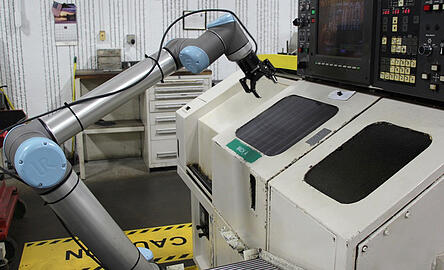Questions on Universal Robots Answered: Here!

Posted on Aug 14, 2015 in Robots
4 min read time
Perhaps you still have some questions concerning Universal Robots. Even if the term collaborative robot is becoming more and more popular in the industry and more models are coming out on the market all the time, there are still questions concerning more basic features of these robots and what they can really achieve. Here are a couple of questions that are frequently asked, which might clarify your understanding.
1. What makes the Universal Robots robot collaborative (without additional safety equipment or guarding)?
First, the robot is force limited. This means that the robot registers if there is an abnormal force experienced during its trajectory. The current in the actuator is used to monitor the force that is registered on the robot arm. You should also notice that different force thresholds can be set to reduce or increase the safety level. In other words, you can set lower speed and force thresholds if the robot is going to act around humans very often and increase this threshold if no human is around the robot. In all cases, the robot is safe for human-robot collaboration and achieves a PL=d Category 3 ISO risk assessment. These safety requirements are the minimum requirement necessary to achieve the ISO 10218 standard for robotic cells.

2. Can any application using Universal Robots be collaborative?
The term collaborative does not only include the robot, but the whole robotic cell. This means all the devices and objects carried by the robot have to be considered in a risk assessment that determines whether or not an application is collaborative. In other words, if you carry a sharp knife with a Universal Robots, even if the robot is ''safe'' the fact that the robot can harm a human makes this application dangerous and thus… NOT collaborative. So the answer to the question is NO, you will have to perform a proper risk assessment to determine if the application done by the Universal Robots is safe enough to be done without any additional safety features.
3. Is the UR controller compatible with machine vision systems?
Yes, the Universal Robots’ controller can be configured to talk with almost any industrial device that communicates via Modbus TCP or Ethernet TCP/IP.
4. How many revolutions are the robot arm joints capable of rotating?
UR5 and UR10 are 6-Axis arms that are capable of turning +/- 360 degrees or two full revolutions at each joint. The new UR3 is capable of the same rotation, but can also infinitely rotate its end joint.

5. What is the robot repeatability?
All robot models have a repeatability of +/- 0.1mm or roughly the size of a human hair. In the following video you can see the repeatability of the UR proven to be even smaller than that.
6. What is the speed limitation for these robots?
All robot models have a speed limitation of 1m/s, but they all have different specification when it comes time to analyze their joint speed (deg/s). The bottom line is that the tool speed is limited by whatever the joint speed is. Remember that you can limit the maximum speed and acceleration in the safety settings. This allows the operator to program his/her own application and not be worried about the speed of the robot. You should also notice that one of the safety features is that the robots can be locked with a password that can limit who can have access to it.
7. Can I have force control without adding another device?
Of course! Depending on your robot model you can have a sensitivity of up to 5N. Which means that the robot will feel forces as low as 5N. When using the arm for this type of operation you can lock down the position of the robot in a vice or in a jig and let the accuracy of the robot arm determine the amount of force to be applied. You might notice that the robot is using the current in its actuators to determine the force applied on the tool. In certain configurations, it is harder to identify the precise force acting on the robot tool in this manner. This is why in some instances it is recommended to use a Force-Torque Sensor such as the Robotiq FT-150 to achieve a more refined accuracy in your force readings for all axes.
If you have any other questions, please leave a comment in the comment section below and we will see if we can answer your interrogations. Because if you have questions it is sure that others will also be wondering the same thing.
Original questions and others provided on the Cross Automation website. Cross Company’s specialty is applying a wide range of technologies to improve machine and manufacturing process performance through their 100% employee-owned specialized sales and engineering teams.







Leave a comment